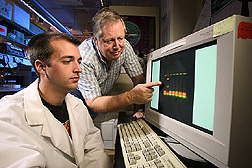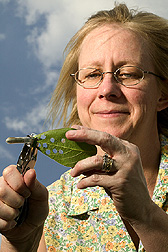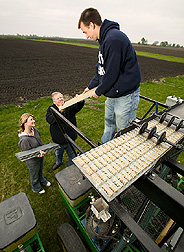TILLING Genes To Improve Soybeans
|
|
A new genetic tool is making it possible to reap many of the benefits of genetic engineering without its disadvantages, whether real or perceived. Among these benefits is breeding better crops—that is, plants that are more nutritious or that can lower risk of developing cancer or food allergies.
The technique is called TILLING—for Targeting Induced Local Lesions In Genomes.
Geneticist Niels Nielsen and biologist Rae Ritchie, both in the ARS Crop Production and Pest Control Research Unit on the campus of Purdue University at West Lafayette, Indiana, are using TILLING to develop soybeans with better seeds. The TILLING strategy was devised by Steven Henikoff and his colleagues at the Fred Hutchinson Cancer Research Center in Seattle. Nielsen and Ritchie are focusing first on improving the oil and protein content of soybeans. Later, they’ll turn to making soybeans allergen free.
Since 2002, they have been using TILLING to create special lines of soybeans for breeding. They’re working with Williams 82 soybeans, adopted by other soybean genome researchers as the standard variety for genome mapping.
First, they soak soybean seeds in a chemical solution—either ethyl methane sulfonate or nitrosomethylurea—to induce mutations.
Then they plant the seeds, grow the mutant soybean plants, harvest a seed from each plant, and grow these second-generation seeds the next summer. Only about 10 percent of the treated seeds survive to this point. From the second-generation plants they harvest leaves and third-generation seeds. DNA from the leaf tissue is extracted and placed in 96-well plates. Each well contains DNA from 8 plants (an “eightfold pool”), so each plate permits analysis of 768 plants.
Showing Them Where It’s At
|
|
Perry Cregan, a geneticist at the ARS Soybean Genomics and Improvement Laboratory in Beltsville, Maryland, provided Nielsen and Ritchie with marker genes to use to analyze mutation frequency.
To find mutations in the genes they are interested in, they make fluorescently tagged primers and use PCR (polymerase chain reaction) to amplify the gene of interest. Then the PCR products are heated to make the DNA strands separate. When the solution cools, the denatured DNA strands reunite. When a mutant strand combines with a normal strand, a mismatch will occur, forming a bulge, or lesion, at the mutation site.
When a specific enzyme is added to the DNA “soup,” it causes the strands to be cut at the lesion. The solution is loaded onto a gel, and the strands are separated by size using a technique called electrophoresis.
Shining ultraviolet light on each gel reveals the sizes of the strands, with the mutant pieces appearing smaller than the others. When a mutation is found in an eightfold pool, the process is repeated on each of the eight individuals to determine which plant has the mutation. The seed from this mutant plant is then sown, and the plants are later tested to see how gene function may have changed.
Finding Out What the Genes Do
The technique of chemically inducing mutations has been around since the 1930s and has been used by plant breeders to introduce useful genetic variation into crop plants. For example, it was used to knock out a gene in rapeseed to make production of edible canola oil possible. But what’s new about TILLING is that it uses automated, robotic equipment to quickly screen for mutations—gene by gene, one piece of DNA at a time. These genetic variations could eliminate or change a gene’s functions.
Nielsen’s TILLING lines of soybeans should offer soybean breeders and genome researchers a valuable resource, making it easier to determine a gene’s function, remove undesirable traits, or create desirable ones.
“With TILLING, you can either find out what genes actually do—so you use the right genes for breeding—or you can find a mutant gene that has the desired trait,” says Nielsen.
Hypoallergenic Soybeans
Eliot Herman, an ARS molecular biologist at St. Louis, Missouri, works on developing hypoallergenic soybeans by eliminating protein allergens from the seeds. In 2003, he and colleagues nationwide used genetic engineering to create a soybean line with a gene that knocks out a major seed allergen. Herman sees TILLING as the next step for creating allergen-free soybeans, particularly for use in baby food or formula. His genetically engineered soybeans are presently not acceptable for that purpose.
Soybeans are one of the top eight allergenic foods, along with peanuts. Food allergies affect 6 to 8 percent of children and 1 to 2 percent of adults. Many children grow out of some of their food allergies (milk for example), which accounts for the differences in adult percentages.
Soybean allergens can cause a skin rash, gastric distress, and other reactions in children and adults and can also affect livestock and, possibly, pets.
TILLING can be used to find mutant genes to create a soybean or other legume line that is free of specific allergens or to find mutant genes that weaken the allergens so they affect even fewer people. It may be difficult to eliminate all the allergens; but the goal is to develop strains with reduced allergenicity.
Nielsen and Herman work with Rick Helm, who is with the Arkansas Children’s Hospital Research Institute/Arkansas Children’s Nutrition Center in Little Rock. Helm is using piglets to study sensitivity to food allergens. Like human infants, some weaned piglets are affected by similar soybean allergens until their immune systems are fully developed.
Helm is also working with Nielsen and Purdue University animal scientist and geneticist Allan Schinckel to develop lines of swine specifically bred for allergen-sensitivity studies.
“We’ll breed a line of swine that is highly sensitive to food allergens in general and a line that is highly tolerant to them,” Helm says. “Then we can test the effects of specific allergen-free crops on the piglets.”
Nielsen notes that next year, United States regulations will mandate labeling of all products with soy as containing a potential allergen.—By Don Comis, Agricultural Research Service Information Staff.
This research is part of Plant, Microbial, and Insect Genetic Resources, Genomics, and Genetic Improvement, an ARS National Program (#301) described on the World Wide Web at http://www.ars.usda.gov/research/programs.htm.
Niels Nielsen and Rae Ritchie are in the USDA-ARS Crop Production and Pest Control Research Unit, 915 West State St., Room 2-464A, West Lafayette, IN 47907-2054; phone (765) 494-8057, fax (765) 494-6508.
"TILLING Genes To Improve Soybeans" was published in the July 2005 issue of Agricultural Research magazine.









